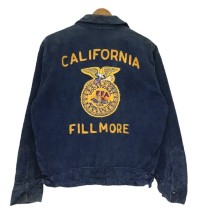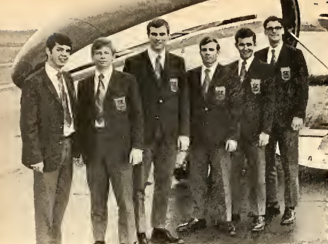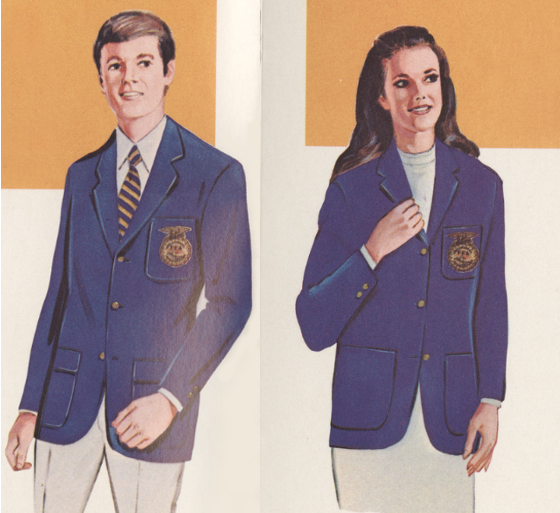In last week’s Footnote Dr. Connors explored the various lettering that has appeared on the back of the FFA jacket over time. This week we explore the inside of the FFA jacket. In other words why do young people wear these jackets?

Figure 1. A FFA Jacket
The body of this Footnote was written in 1977 by D. Lanette Vaughn and appeared in the February issue of The Agricultural Education Magazine. Some of you knew Lanette as the wife of Paul Vaughn. Paul and I were graduate students at Ohio State at the same time. That is where I met her. At the time she wrote this, Paul was on the faculty at Virginia Tech and Lanette was a graduate student there.
Lanette is now retired and splits her time between Missouri and Florida with her two dogs Princess and Boss. Her daughter works in academia and her son works in technology. Together, they have blessed her with five grandsons who she loves to spoil whenever she gets the chance.
The FFA Jacket
By D. Lanette Vaughn
When J. H. Lintner designed the first FFA jacket for his Fredericktown, Ohio Chapter members to wear at the 1932 National Convention, it is doubtful that he realized the tremendous influence the jacket was to have on the FFA organization. It is also unlikely that anyone during that early period would have thought that forty years later the FFA organization would be selling more than 100,000 jackets annually and would become the largest single purchaser of corduroy in the United States.
What is it that caused this simple blue and gold garment to become the most recognized clothing apparel in public schools across the United States? Has it just been tradition, or is there another reason? Is it possible that there might be a very sound educational basis for wearing the FFA jacket? A review of the basic concepts of clothing and individual behavior suggests that there is, and agricultural educators should be aware of them and their implications for the FFA. In brief, these concepts (and how they apply to the FFA) are as follows:
NEEDS
One of the basic needs of human beings is the need to belong. As children grow into adolescents, their desire to identify with the herd shifts to a desire to identify with a small group—a group with similar characteristics and with similar backgrounds and beliefs. If we transfer this premise, basic to all human beings, to the adolescent age group; it brings into focus our youth organization—the FFA. The FFA is an organization that can bring adolescents with similar characteristics, backgrounds, and beliefs together into a group which can, in turn, strive to meet their needs.
On one hand the FFA is a small, close-knit group of immediate friends, but yet on the other, it is a national organization. How can an entire nation of these young people be joined together so they are easily recognized by all members and the public in general? Clothing, being the most conspicuous and most visual badge of group belonging, is the obvious answer. The FFA jacket serves as the tool to draw this large, national group of young people together. This uniform furnishes the members overt identification with their group. It gives the individual a part of the power, importance, and approval of others that is generated by the FFA.
It is possible that a group of young people might not have a particular affinity for others who are near the same age and come from similar backgrounds—in other words, they could lack “group consciousness.” This group consciousness can be increased if the group identifies itself with a name; for example, “The FFA.” Their togetherness might be further increased if they competed against other groups in activities, e.g. public speaking. Heightened by the challenge and competitive nature of this activity, their sense of unity would be strengthened. However, the group might still lack identity. For example, during a public speaking contest, how will the members identify with the individual giving the speech if they don’t know this individual personally? How can they support the speech and feel it is “theirs”? Each member needs a conspicuous emblem of membership in the group. Again, the most obvious answer is the most visible — a uniform with which all members can identify. Possibly the most important service the FFA jacket can perform for the FFA is to pull individuals together to form a group which has a high degree of group consciousness. This is in accordance with the concept that the extent to which members will identify with a group will depend on each individual’s consciousness or awareness of the group’s existence and his/her part of this group.
UNIFORM
We have said that a uniform can bring the group together giving them an identity, but it can also set the group apart. It is necessary that it distinguish them from other groups. It must set them apart as different and unique. The FFA jacket serves this function. Adolescents have joined the FFA because it exemplifies certain beliefs, which they as individuals hold. The jacket distinguishes this group from others in their school, their community, and the nation by signifying these beliefs and attitudes.
It is often said that clothing is an extension of the self, that is; it functions in a group to extend the feelings of the self beyond the physical boundaries of the body. It provides an expansiveness of the wearer’s attitudes and emotions. Consciously, or unconsciously, every individual reflects through clothing a set of beliefs that he or she wants others to believe about him or herself. The FFA jacket serves to let others know the type of person the individual is and what he or she holds to be important. It distinguishes the individual from the others in the general population.
QUESTIONS
We have talked about what the jacket can and has done for the organization, but maybe we should pose some questions about this symbol of group identity and its future with the FFA. For example, should the jacket continue to be made of corduroy? Is this the most durable, easy to care for, attractive fabric? Could the future FFA jacket be constructed from a more washable, tougher, better-looking fabric? Does the jacket really do the most for our newest members, the girls? Does it really look attractive and sharp when worn with skirts? Also, a side question: are advisors willing to let the female members wear this jacket with pants (as it was probably designed to be worn)? Is a corduroy jacket the best and most appropriate wearing apparel for formal occasions?
Finally, if the jacket is to be changed, how much should it be changed? We must keep in mind that if it is altered too much, this symbol of beliefs may lose the sense of identity it has developed over the past forty years. However, we also must remember that if the jacket does not keep in step with the desires of the members, its benefits will likely be permanently lost.
Curator’s Closing Remarks
It is interesting that Lanette’s final two paragraphs revolve around questions related to changing the jacket. There have been times in the past when the FFA considered changing the jacket.
At the July 1964 FFA Board of Directors meeting a motion was approved to allow the national FFA Officers to wear blue blazers with a FFA emblem on the pocket for special occasions. This action was prompted by letters from several donors suggesting the officers wear some type of “dress jacket” during the National Goodwill Tour and at other public relations events.

Figure 2. 1969 -70 National Officers wearing their blue blazers.
Image from The National Future Farmer, June-July 1970.
These blue blazers were actually carried by the FFA Supply Service for a while. There was even one for female members.

Figure 3. From the 1972-73 FFA Supply Service Catalog
In the 1990s there was again discussion about changing the FFA jacket. During the 1993 FFA convention there was a display of four different styles of possible FFA jackets on the floor of the career show. One style was the current corduroy jacket, one was the blue blazer, one was a letterman style jacket, and I don’t remember the fourth style. FFA members were asked to vote on the style they liked best. The results of the voting were what you would expect of gung-ho FFA members attending the national convention—the traditional jacket won out. However, questions about the FFA jacket should be asked from time to time.
What can we learn from Lanette’s article? While the jacket does convey a message, the agriculture teacher and program speak even louder. Do you and your program welcome all students and give them a sense of belonging? Just as the jacket conveys a message about the characteristics of the wearer, what type of message do you and your members convey to others about the characteristics of your program?
